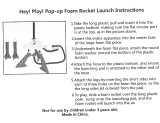Speaker Operation
The speakers have an efficiency (SPL) level around 85 dB. This means
that low power amplifiers (25 watts per channel) will give good results.
To adequately reproduce the high dynamic levels of quality recordings
and CD, power audio amplifiers rated up to the power handling
specifications may be necessary.
Precaution
The speakers used in Altec Lansing systems can handle large peaks of
power without damage. This is achieved by special high temperature
wire, adhesive and coil forms. However, damage may occur to the
midrange and tweeter when these speakers are operated from
amplifiers that are highly distorted. Usually some lower power handling
amplifiers are easily driven into “clipping” levels. Even though the
amplifiers are low power, the distorted wave forms can cause damage
more so than the high power clean amplifiers.
In some room locations, speaker performance can be enhanced by
raising the cabinet off the floor. Stabilizers or “feet” in varying heights
are available in high fidelity outlets and raise the cabinet slightly
providing smoother bass response.
Warranty Information
30-Day Satisfaction Guarantee
If for any reason you decide that these loudspeakers do not meet your
expectations, you may return them to Altec Lansing (at Altec Lansing’s
expense) using the original packaging material within 30 days of
receipt. You retain the risk of loss until the goods are received by Altec
Lansing, accordingly, you should insure the loudspeaker shipment for
your benefit. For additional information and to receive a Return
Merchandise Authorization (RMA), please contact Altec Lansing using
the information below.
One-Year Warranty on Components
Altec Lansing warrants to you, the original purchaser, that for one year
from the date you receive these loudspeakers, these loudspeakers shall
not suffer loss of functionality due to manufacturing defects in any
loudspeaker component. Altec Lansing’s sole obligation and your sole
remedy under this one-year warranty is that Altec Lansing shall provide
you, the original purchaser, with replacement loudspeakers for
loudspeakers that suffer loss of functionality due to manufacturing
defects within one year of the date you receive these loudspeakers.
Altec Lansing shall deliver replacement loudspeakers by common carrier,
and shall additionally provide you a pre-paid shipping box for returning
the defective loudspeakers.
This one-year warranty does not cover cosmetic defects or cosmetic
problems resulting from transportation or handling.
If You Are Having Trouble
Your Altec Lansing loudspeakers are precision instruments, responding
with high accuracy to the variations in electric current produced by
other components in your system. Extraneous noise such as hum,
rumble, or hissing do not originate in the loudspeakers. If you
experience difficulty in realizing the fine performance built into your
Altec Lansing loudspeakers, you may contact us directly.
Altec Lansing Technologies, Inc.
535 Routes 6 & 209
Milford, PA 18337-0277
1-866-570-5702 Toll-Free Technical Support
We want you listening for a lifetime
Selecting fine audio equipment such as the unit you have just
purchased is only the start of your musical enjoyment. Now it’s time to
consider how to maximize the fun and excitement your equipment
offers. This manufacturer and the Electronic Industries Association’s
Consumer Electronics Group want you to get the most out of your
equipment by playing it at a safe level. One that lets sound come
through loud and clear without annoying blaring or distortion – and,
most importantly without affecting your sensitive hearing.
Sound can be deceiving. Over time your hearing “comfort level” adapts
to higher volumes of sound. So what sounds “normal” can actually be
loud and harmful to your hearing. Guard against this by setting your
equipment at a safe level BEFORE your hearing adapts.
To Establish a Safe Level
• Start your volume control at a low setting.
• Slowly increase the sound until you can hear it comfortably and
clearly and without distortion.
• Once You Have Established a Comfortable Sound Level, set the dial
and leave it there.
Taking a minute to do this now will help prevent hearing damage or
loss in the future. After all, we want you listening for a lifetime.
Used wisely, your new sound equipment will provide a lifetime of fun
and enjoyment. Since hearing damage from loud noise is often
undetectable until it is too late, this manufacturer and the Electronic
Industries Association’s Consumer Electronics Group recommend you
avoid prolonged exposure to excessive noise. This list of sound levels is
included for your protection.
Decibel
Level Example
30 Quiet library, soft whispers
40 Living room, refrigerator, bedroom away from traffic
50 Light traffic, normal conversation, quiet office
60 Air conditioner at 20 feet, sewing machine
70 Vacuum cleaner, hair dryer, noisy restaurant
80 Average city traffic, garbage disposals, alarm clock at two feet
The Following Noises Can Be Dangerous Under Constant
Exposure
90 Subway, motorcycle, truck traffic, lawn mower
100 Garbage truck, chain saw, pneumatic drill
120 Rock band concert in front of speakers, thunderclap
140 Gunshot blast, jet plane
180 Rocket launching pad
Information courtesy of the Deafness Research Foundation
FIGURE 3

















